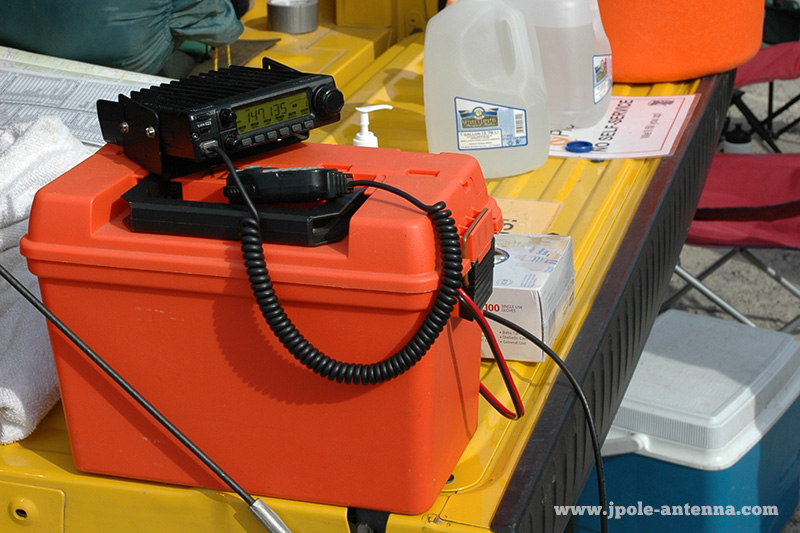Summer time usually gets pretty active in the life of an emergency communications volunteer. When we don’t have severe weather to capture our attention, we are out volunteering our services as communicators for community events. One such event I help out with is a multi-day bicycle tour that winds through the state of Wisconsin.
 Events like bike tours are a great way to flex your Emergency Communication (Emcomm) muscles. Unlike marathons and walk-athons that have shorter, more compact courses, a bike tour can have a route as long a 100 miles a day. Plus the routes are linear, so coverage can get very spotty in rural areas. In working with the Bike Wisconsin people for more than 10 years, I’ve learned what it takes to put together an Emcomm field kit that works in a variety of situations.
Events like bike tours are a great way to flex your Emergency Communication (Emcomm) muscles. Unlike marathons and walk-athons that have shorter, more compact courses, a bike tour can have a route as long a 100 miles a day. Plus the routes are linear, so coverage can get very spotty in rural areas. In working with the Bike Wisconsin people for more than 10 years, I’ve learned what it takes to put together an Emcomm field kit that works in a variety of situations.
In planning the communications for the route, we strive to take advantage of high profile repeaters whenever possible. When we are in the range of the repeater things work great, and some aid stations even can use handheld radios. But sometimes the aid station is located at a park or other public space that has terrible coverage from the repeater. In these instances handheld radios don’t work and even the mobile in the car has spotty coverage. These situations call for my Emcomm field kit.
 My field kit is nothing more than an Icom IC-2100 radio with a 18ah gel cell battery. What makes the kit work is the 10 foot painters pole and 2 meter J-Pole antenna. The kit is lightweight and portable and can be send up and disassembled in 10 minutes or less. Add to that a 50 foot length of RG-8X (mini-8) coax and I can have the radio in a convenient spot while placing the antenna out of the way.
My field kit is nothing more than an Icom IC-2100 radio with a 18ah gel cell battery. What makes the kit work is the 10 foot painters pole and 2 meter J-Pole antenna. The kit is lightweight and portable and can be send up and disassembled in 10 minutes or less. Add to that a 50 foot length of RG-8X (mini-8) coax and I can have the radio in a convenient spot while placing the antenna out of the way.
I have a small piece of fence post that I pound into the ground and attach the mast to. But if I’m in an area that doesn’t have soil suitable to pound in stake, I’ll lash the mast to a signpost, fence or other sturdy vertical structure. A couple of hose clamps are used to attach the antenna to the mast, but electrical tape or zip ties also work great in a pinch.
How does the kit work in the field. Unlike handheld radios, the mobile’s extra power and sensitivity gives you an edge in communicating in fringe areas. Plus putting an antenna with gain (like the 2 meter J-Pole) up in the air almost always gets you out of those communication holes. The 18Ah gel cell battery will give you a couple of days of power, but if I’m working the event for more than one day, I’ll bring a small battery charger to recharge the battery overnight.
Sometimes using a portable is advantageous, especially if you need to move about the area. In those instances, I’ve swapped out my single band Icom with a dual band Yaesu FT-8900R. The Yaesu has the ability to cross-band repeat, so I can set the rig and antenna up in the cross band mode, and then use my UHF handheld radio radio to communicate with the VHF repeater. With the antenna up about 10 feet in the air, the J-Pole will give you about a 1/2 mile radius of coverage in clear terrain, which is plenty in most instances.
During the summer months, the antenna kit lives in the trunk of my car (the 2 meter breakaway J-Pole is great for keeping in the trunk). The charged battery and radio are in the house, but when it’s need, I can grab the whole kit and go in 15 minutes or less.
I hope this gives you some ideas on putting together an Emcomm kit for field use. In fact, I’d love to hear about what you take in the field with working emergency communications or providing health and welfare communications at an event.
Recent Comments